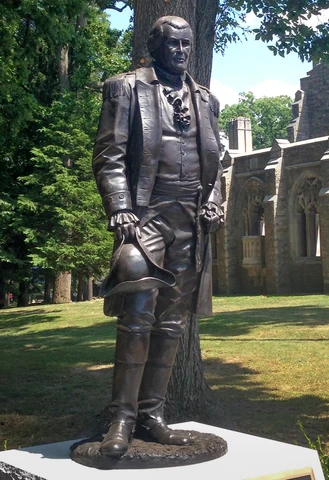“No body ever heard of a quarter Master in History as such”
As part of last weekend’s History Camp Valley Forge, I signed up for a tour of “F.O.B. Valley Forge” led by Army War College professor Ricardo A. Herrera, author of Feeding Washington’s Army: Surviving the Valley Forge Winter of 1778.
I’ve visited Valley Forge before, but I was pleased to view the terrain again with an expert guide.
While standing in front of the oversized mounted statue of Gen. Anthony Wayne, Herrera spoke about how the Continental Army’s supply problems that winter were exacerbated by the lack of a quartermaster general. Thomas Mifflin resigned from that administrative post (for the second time) in November 1777.
In March 1778, Gen. George Washington finally twisted the arm of his most trusted lieutenant, Nathanael Greene, to take that job. It had been filled by civilians before, and Greene insisted on a promise that he could return to his army rank afterwards.
A year later, on 29 Apr 1779, Greene made his ongoing feelings about the assignment clear in a letter to Washington:
Greene put Wayne in charge of the main part of that effort. Col. Henry Lee and Cmdre. John Barry scoured other areas. That campaign for supplies kept the army together in the spring of 1777.
As I looked up at the statue of Wayne, I wondered whether there was a similar statue of Greene, given his importance. So I did some quick web-searching. Washington, Wayne, and Steuben appear to have been the only generals with standalone statues in Valley Forge National Park until this century.
In 2015, a statue of Greene by Susie Chisholm was put up near the Washington Memorial Chapel. It’s life-sized, not oversized. It’s on foot, not mounted. And I suspect it’s at that location because the chapel and its grounds are episcopal property, not part of the national park. (The National Park Service is in the business of preserving statues and monuments, not installing new ones.) Chapters of the Sons of the American Revolution funded this memorial.
And that public artwork is making sure that somebody has heard of a quartermaster.
I’ve visited Valley Forge before, but I was pleased to view the terrain again with an expert guide.
While standing in front of the oversized mounted statue of Gen. Anthony Wayne, Herrera spoke about how the Continental Army’s supply problems that winter were exacerbated by the lack of a quartermaster general. Thomas Mifflin resigned from that administrative post (for the second time) in November 1777.
In March 1778, Gen. George Washington finally twisted the arm of his most trusted lieutenant, Nathanael Greene, to take that job. It had been filled by civilians before, and Greene insisted on a promise that he could return to his army rank afterwards.
A year later, on 29 Apr 1779, Greene made his ongoing feelings about the assignment clear in a letter to Washington:
There is a great difference between being raisd to an Office and decending to one; which is my case. There is also a great difference betwext serving where you have a fair prospect of honor and laurels, and where you have no prospect of either let you discharge your duty ever so well. No body ever heard of a quarter Master in History as such or in relateing any brilliant Action.But Greene was doing the job. His first big action as quartermaster general, Herrera explained, was to launch a “grand forage,” sending troops out into the countryside around Valley Forge to collect every type of supply that the army needed, paying in Continental scrip whether farmers were happy about that or not.
Greene put Wayne in charge of the main part of that effort. Col. Henry Lee and Cmdre. John Barry scoured other areas. That campaign for supplies kept the army together in the spring of 1777.
As I looked up at the statue of Wayne, I wondered whether there was a similar statue of Greene, given his importance. So I did some quick web-searching. Washington, Wayne, and Steuben appear to have been the only generals with standalone statues in Valley Forge National Park until this century.
In 2015, a statue of Greene by Susie Chisholm was put up near the Washington Memorial Chapel. It’s life-sized, not oversized. It’s on foot, not mounted. And I suspect it’s at that location because the chapel and its grounds are episcopal property, not part of the national park. (The National Park Service is in the business of preserving statues and monuments, not installing new ones.) Chapters of the Sons of the American Revolution funded this memorial.
And that public artwork is making sure that somebody has heard of a quartermaster.


1 comment:
Speaking as a former RI Historical Society employee, can't get enough Nathanael Greene!
Masters of logistics may largely be unsung heroes in the martial domain, but armies couldn't win without them.
(Although NG's fatal postwar foray into plantation-owning certainly puts a blot on his outstanding record. Sincerely wish he hadn't ended his life as a Georgia slaveholder...)
Post a Comment